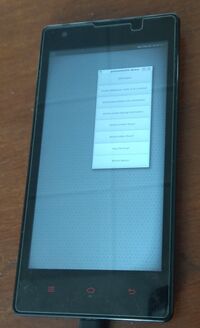Xiaomi Redmi 1S (xiaomi-armani)
Appearance
| This device is still running on armhf, although the processor supports armv7. If you own it, change it and test it that way. |
| This device runs a Downstream kernel. Some UIs will not work, and most features (3D acceleration, audio, etc.) may be broken. |
 PostmarketOS running on Xiaomi Redmi 1S | |
| Manufacturer | Xiaomi |
|---|---|
| Name | Redmi 1S |
| Codename | xiaomi-armani |
| Released | 2014 |
| Type | handset |
| Hardware | |
| Chipset | Qualcomm Snapdragon 400 (MSM8226) |
| CPU | Quad-core 1.6 GHz Cortex-A7 |
| GPU | Adreno 305 |
| Display | 720x1280 WLED |
| Storage | 8GB eMMC, external micro-sd slot |
| Memory | 1 GB |
| Architecture | armv7 |
| Software | |
Original software The software and version the device was shipped with. |
Android 4.3 (MIUI 6.0) |
Extended version The most recent supported version from the manufacturer. |
Android |
| postmarketOS | |
| Category | downstream |
Mainline Instead of a Linux kernel fork, it is possible to run (Close to) Mainline. |
no |
| Device package |
|
| Kernel package |
|
Flashing Whether it is possible to flash the device with pmbootstrap flasher. |
Works
|
|---|---|
USB Networking After connecting the device with USB to your PC, you can connect to it via telnet (initramfs) or SSH (booted system). |
Works
|
Battery Whether charging and battery level reporting work. |
Untested
|
Screen Whether the display works; ideally with sleep mode and brightness control. |
Works
|
Touchscreen |
Works
|
| Multimedia | |
3D Acceleration |
Untested
|
Audio Audio playback, microphone, headset and buttons. |
Untested
|
Camera |
Untested
|
| Connectivity | |
WiFi |
Works
|
Bluetooth |
Untested
|
GPS |
Untested
|
| Modem | |
Calls |
Untested
|
SMS |
Untested
|
Mobile data |
Untested
|
| Miscellaneous | |
FDE Full disk encryption and unlocking with unl0kr. |
Untested
|
| Sensors | |
Accelerometer Handles automatic screen rotation in many interfaces. |
Untested
|
Contributors
- alive4ever
What works
- USB ethernet
- Flashing, via android-recovery-zip (twrp) and pmbootstrap flasher
- Touchscreen (ft5x06_i2c)
- Screen: framebuffer (/dev/fb0), backlight & brigtness control (/sys/class/leds/wled:backlight/brightness)
- Notification leds (/sys/class/leds/red/brigtness, /sys/class/leds/green/brightness, /sys/class/leds/blue/brightness)
- Wifi: via wcnss-wlan and wlanarmani service (which does modprobe wlan on system boot after wcnss-wlan service has been initialized)
- Xwayland
- Battery: charging status (/sys/class/power_supply/battery/status), capacity reporting (/sys/class/power_supply/battery/capacity)
- Buttons: KEY_POWER, KEY_VOLUMEUP, and KEY_VOLUMEDOWN (triggerhappy can be used to handle them, see Troubleshooting:HID_buttons)
What does not work
- Screen: framebuffer console (no kernel boot log printed on the display), directfb applications (osk-sdl and charging-sdl)
- Wifi: rfkill (no support for blocking wireless via rfkill block wifi or nmcli radio wifi off). The only way to block wireless is unloading wlan module (``rmmod wlan`` or ``/etc/init.d/wlanarmani stop``)
- Sound: don't know how to initialize the sound card
- Other hardware features are untested (3D, bluetooth, modem, gps, accelerometer)
- Xorg based UI: postmarketos-ui-xfce4 displays nothing on the screen.
How to enter flash mode
- Entering fastboot: hold + buttons until fastboot mode is displayed on the screen.
- Entering recovery: hold + buttons. The default is Mi Recovery. TWRP is needed for installation, which can be obtained here
Installation
pmbootstrap flasher method
- Put the device into fastboot mode by holding both + buttons or rebooting into bootloader from the twrp reboot menu.
- Connect the device to the computer via usb cable
- Bootstrap PostmarketOS
$ pmbootstrap init #select xiaomi-armani$ pmbootstrap install
- Flash the kernel and system
$ pmbootstrap flasher flash_kernel$ pmbootstrap flasher flash_rootfs
- Reboot the device
$ fastboot reboot
Android recovery.zip sideload method
- Put the device into TWRP recovery, either by booting twrp image via fastboot directly or by pressing + button after flashing TWRP recovery image.
- Connect the device to the computer via usb cable
- Bootstrap PostmarketOS
$ pmbootstrap init #select xiaomi-armani
$ pmbootstrap install --android-recovery-zip
$ pmbootstrap export # generate symlinks inside /tmp/postmarketOS-export directory
- Put the twrp recovery into sideload mode
$ adb shell "twrp sideload"
- Start sideloading the recovery file
$ adb sideload /tmp/postmarketOS-export/pmos-xiaomi-armani.zip
- Reboot the device
$ adb reboot
Additional info
It's necessary to unplug the usb cable after issuing ``poweroff`` command to properly shut down PostmarketOS.
Don't leave screen on for a long time, otherwise there will be LED burn-in. If the display screen is not used, turn the screen off.
$ echo 0 | sudo tee "/sys/class/leds/wled:backlight/brightness"
The screen can be turned on with maximum value up to 4095
$ echo 3072 | sudo tee "/sys/class/leds/wled:backlight/brightness"
Battery state can be monitored. Refer to Battery capacity monitoring for more information.
Hardware enablement effort
- Framebuffer: directfb based applications don't work (osk-sdl and charging sdl)
- Sound: unable to initialize the sound card on PmOS
See also
- !1204 Initial pull request
- LineageOS wiki page